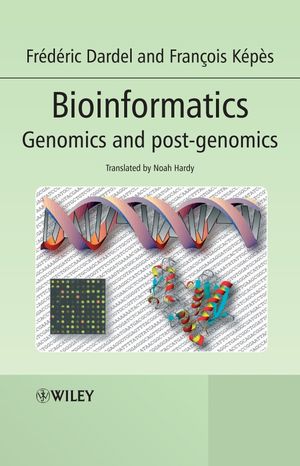Bioinformatics: Genomics and Post-GenomicsISBN: 978-0-470-02001-2
Hardcover
272 pages
September 2006
 This is a Print-on-Demand title. It will be printed specifically to fill your order. Please allow an additional 10-15 days delivery time. The book is not returnable.
|
||||||
1.1 Automatic sequencing.
1.2 Sequencing strategies.
1.3 Fragmentation strategies.
1.4 Sequence assembly.
1.5 Filling gaps.
1.6 Obstacles to reconstruction.
1.7 Utilizing a complementary ‘large’ clone library.
1.8 The first large-scale sequencing project: The Haemophilus influenzae genome.
1.9 cDNA and EST.
Chapter 2. Sequence comparisons.
2.1 Introduction: Comparison as a sequence prediction method.
2.2 A sample molecule: the human and rosterone receptor.
2.3 Sequence homologies - functional homologies.
2.4 Comparison matrices.
2.5 The problem of insertions and deletions.
2.6 Optimal alignment: the dynamic programming method.
2.7 Fast heuristic methods.
2.8 Sensitivity, specificity, and confidence level.
2.9 Multiple alignments.
Chapter 3. Comparative genomics.
3.1 General properties of genomes.
3.2 Genome comparisons.
3.3 Gene evolution and phylogeny: applications to annotation.
Chapter 4. Genetic information and biological sequences.
4.1 Introduction: Coding levels.
4.2 Genes and the genetic code.
4.3 Expression signals.
4.4 Specific sites.
4.5 Sites located on DNA.
4.6 Sites present on RNA.
4.7 Pattern detection methods.
Chapter 5. Statistics and sequences.
5.1 Introduction.
5.2 Nucleotide base and amino acid distribution.
5.3 The biological basis of codon bias.
5.4 Using statistical bias for prediction.
5.5 Modeling DNA sequences.
5.6 Complex models.
5.7 Sequencing errors and hidden Markov models.
5.8 Hidden Markov processes: a general sequence analysis tool.
5.9 The search for genes - a difficult art.
Chapter 6. Structure prediction.
6.1 The structure of RNA.
6.2 Properties of the RNA molecule.
6.3 Secondary RNA structures.
6.4 Thermodynamic stability of RNA structures.
6.5 Finding the most stable structure.
6.6 Validation of predicted secondary structures.
6.7 Using chemical and enzymatic probing to analyze folding.
6.8 Long-distance interactions and three-dimensional structure prediction.
6.9 Protein structure.
6.10 Secondary structure prediction.
6.11 Three-dimensional modeling based on homologous protein structure.
6.12 Predicting folding.
Chapter 7. Transcriptome and proteome: macromolecular networks.
7.1 Introduction.
7.2 Post-genomic methods.
7.3 Macromolecular networks.
7.4 Topology of macromolecular networks.
7.5 Modularity and dynamics of macromolecular networks.
7.6 Inference of regulatory networks.
Chapter 8. Simulation of Biological Processes in the Genome Context.
8.1 Types of simulations.
8.2 Prediction and explanation.
8.3 Simulation of molecular networks.
8.4 Generic post-genomic simulators.
Index.



